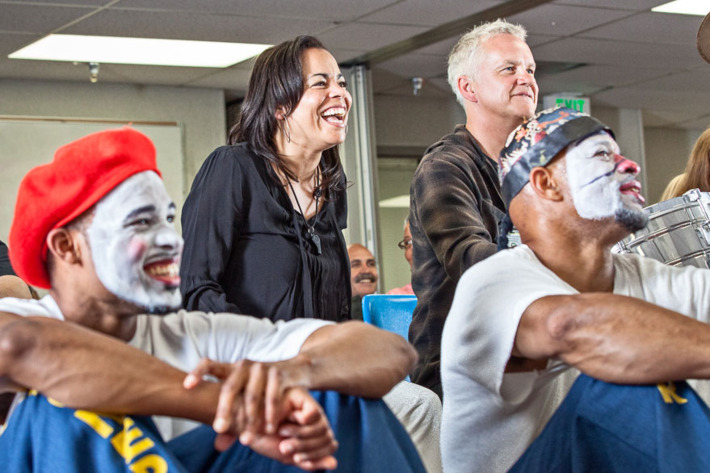
Sabra Williams, Tim Robbins, and inmates in an Actor’s Gang Prison Project class at the California Rehabilitation Center.Photo: Peter Merts
The Vindicated
NYMag.com
November 14, 2016 5:27 p.m.
Tim Robbins’s Prison Improv Classes Make Inmates Less Likely to Re-Offend
By Mickey Rapkin
ShareTweetSharePin ItEmail
Sabra Williams, Tim Robbins, and inmates in an Actor’s Gang Prison Project class at the California Rehabilitation Center.Photo: Peter Merts
You can imagine how this idea was received 10 years ago, but here’s the pitch: A tenacious British actress teams up with Oscar winner Tim Robbins to bring acting classes to maximum-security prisons. And not just any acting classes, but improv workshops that ask Crips and Bloods and convicted murderers and white supremacists to sit together, wear makeup and masks, and maybe even pretend to be women sometimes. The eight-week intensive is meant to help the incarcerated better handle their emotions. But if you think it sounds more like the treatment for an Orange Is the New Black spinoff than a serious attempt at criminal-justice reform, you’re not alone.
“People said, ‘Yeah, yeah, you want to give them crayons. You’ve got acting classes?’” recalls Robbins of the launch of the Actors Gang Prison Project. “We’re like, ‘No, we don’t want anyone to be an actor. There’s too much unemployment in that. It’s about changing behavior.” Fundraising was a slog. Correctional officers pushed back. And these actor-facilitators were dismissed as another merry band of liberals pushing what’s known in the Prison Industrial Complex as “hug-a-thug” programming.
Sabra Williams, the co-founder and executive director of the Prison Project — who also had a small part in Kristen Wiig’s Welcome to Me last year — remembers those early days. “There was so much opposition with lots of COs telling me, ‘Why are you wasting your time with these losers?’” she says. “A few haters thought we were giving inmates too much power. One spread rumors that I was having an inappropriate relationship with a student.”
Yet, despite the haters, the Prison Project celebrated its 10th anniversary this year, and will expand to 10 California prisons in February 2017, just as some hard data has finally come in to prove the program’s merits. The recidivism rate in the state is more than 50 percent. But a recent preliminary study by the California Department of Corrections and Rehabilitation showed that, for inmates who completed the Prison Project, that number dropped to 10.6 percent. Critics will point to a sample size that’s too small to draw broad conclusions, and it’s a valid concern. But the provisional findings are encouraging, to say the least.
There is now immense support from inside the prison system, and public opinion is shifting, thanks in part to Robbins and Williams’s up-from-the-bootstraps lobbying efforts. Governor Jerry Brown approved a $6 million line item in California’s 2016–2017 budget earmarked specifically for Arts in Correction, a partnership between the CDRC and the California Arts Council, up from $2 million the previous year. And in 2017, all 35 prisons in California will have at least some kind of publicly funded arts program — up from exactly zero a decade ago.
Photo: Peter Merts
Former Attorney General Eric Holder is a vocal supporter of the Prison Project; after meeting with Williams and Robbins in Washington in 2014 to discuss criminal justice reform, he traveled to the California Rehabilitation Center in Norco, CA to observe their work firsthand. “This is the kind of innovative initiative that legislatures on all levels should support,” Holder told me. “The effort led by Sabra and Tim points the way to a more successful rehabilitation and re-entry process.”
In an interesting twist, Ronald L. Davis — whom President Obama appointed as the executive director of his Task Force on 21st Century Policing — recently expressed interest in having the Actors Gang create similar classes to train police officers in emotional intelligence and de-escalation techniques. In the spring, Williams says she’ll apply for a grant with the hopes of doing just that.
Before we get to how she and the star of The Shawshank Redemption were initially laughed out of the room, it helps to look at why their work is so vital—and, yes, maybe even bipartisan. As Holder pointed out in an August New York Times op-ed, crime rates in America are at historic lows. But incarceration numbers have more than quadrupled since the 1970s. Roughly 2.3 million Americas are in prison, meaning we have 5 percent of the world’s population but 22 percent of its prisoners.
Some conservatives may not want to give inmates crayons, but Williams would argue we can’t afford not to. In 2010, it cost about $80 billion per year to house people in our prisons and jails. Or between $45,000 and $60,000 dollars per adult. “Our class costs $1,500 per year for that person,” she says. “When the majority of them don’t come back to prison, they’re saving California a lot of money.”
Teaching inmates to diffuse their emotions through 16-century commedia dell’arte improv exercises may seem like an unlikely cost-cutting measure, but that’s exactly what it could turn out to be. Williams first had the idea a decade ago, around the time she joined Robbins’s L.A.-based theater company, the Actors Gang. She’d moved to Los Angeles from London where, as part of the English Shakespeare Company, she’d gone into prisons to perform the Bard’s Roman plays. She saw first-hand the effect these visits and workshops had on the incarcerated. She’d just assumed that the Actors Gang already had a similar program in place. Robbins responded: “We don’t. Make something happen.”
Photo: Peter Merts
What happened next was a classic fake-it-till-you-make-it story. Williams cold-called the California Institution for Men in Chino — where Edward Norton’s character served time in American History X — and asked the community resources director there if he’d be interested in a free acting program. “It was really good that I was very naïve,” she says. “He was like, ‘Yeah, get in here.’ It didn’t cost him anything. Literally, I just bullshitted to three other actors that I knew what I was doing, and we went in a car on a wing and a prayer and did our workshop.”
The acting exercises they were doing were similar to what the Actors Gang members do themselves every Sunday. The inmates sit on the floor in a circle and wear white makeup and masks (keep reading, conservatives!), improvising scenes as characters from the commedia dell’arte tradition. We’re talking about stock characters like Pantalone (a cheap merchant), Arlechinno (a mischievous servant), and Capitano (a pompous military captain known for inflating his status). In a way, this all makes complete sense. The 16th-century style of theater from Italy and France started as a way for peasants to satirize the upper class. (The roving troupes of actors wore white makeup so they could be seen in twilight.)
Photo: Peter Merts
Christopher Bisbano, who spent 18 years in prison on attempted murder charges, participated in one of those early classes. “It was three women and one guy and they all had on, like, jogging suits and running shoes. I thought we were going to do cartwheels or something,” Bisbano recalls. “We discussed what the work was about, then what was expected of us. Sabra talked about this early-16th-century form of theater. How this type of style works is you work from a state, one of the four core emotions: happy, sad, frightened, or angry.”
The work was challenging for many reasons, but also maybe one: because it requires inmates to look directly into each other’s eyes, which is rare in prison. “You’re not supposed to show happy or sad or being frightened,” says Bisbano. “It’s a sign of weakness.”
Robbins recalls a moment in year two of the program when the full weight of this work hit him. “One of the guys” — Robbins prefers incarcerated person over the word prisoner — “said, ‘I didn’t realize until I took this class that I’ve been wearing a mask on the yard for 20 years. That angry face, that tough guy, that’s not the total of me. That’s just a part of me that I do for survival. But there’s another part of me that is capable of feeling and expressing other emotions other than anger.”
Robbins’s first thought (“Oh my God, it’s transformed people”) led to a second, scarier revelation: “Oh, shit. We’re going to have to do this.”
That first year, the Actors Gang Prison Project cut its teeth at the California Institution for Men with an eight-week program, one day a week for four hours. For year two, it was the California Institution for Women, then the California Rehabilitation Center in Norco, where they’ve remained for nine years — in both the general population yard and on the sensitive needs yard (for those who would be attacked or killed in general population, often because of the nature of their crimes or gang issues). In the lean, early days — even when wardens and COs invited them inside, the money wasn’t there. At a minimum, the class cost $5,000 to run, which just about covered transportation and materials. Williams would go out and raise the money, run the eight-week class, then go right back out to find more money so they could do it again. Even as public opinion on judicial reform began evolving, the economic collapse decimated funding for Arts in Corrections.
Photo: Peter Merts
There were other hiccups. Williams and her staff are frequently alone in rooms with inmates who’ve been convicted of murder, drug dealing, and rape. They’re working with women who killed their husbands. But discipline problems have been almost nonexistent. Williams did once receive a love letter from a prisoner, which Robbins read aloud in class. “We do things publicly,” Williams explains. “That’s the culture of the class. It’s important in terms of safety and people knowing that we’re aware of the rules and we know where we are. We’ve never thrown anyone out in ten years.” The man who wrote the letter left the class. But a year later, he came back, sat down, and did the work. No one ever mentioned it again.
Beyond recidivism, the Actors Gang Prison Project work has led to a nearly 90 percent reduction in behavioral infractions for participants, one of the unexpected effects the program has had outside of class. “What it did was it started to change the culture on the yard,” Bisbano says. “There were no racial boundaries in class. The African-Americans, the whites, Mexicans, Hispanics, we were all playing together. It’s very rare in prisons, especially in California. When we had our presentations, we would invite other inmates to come watch. Then they would see that their homeboy was up there dressed up like some character, acting like a fool. It started to break some boundaries. We had something special in common.”
“To be able to share personal stories in character, without judgment,” he adds, “basically it’s providing a safe place, a sacred place, where we could go and get into these characters and see what relationships developed.”
Photo: Peter Merts
Jeffrey Beard, who was secretary of California’s Department of Corrections until he resigned in January, was instrumental in legitimizing the Prison Project program, talking about the work as “behavioral therapy,” which certainly sounds more convincing than crayons. After Holder invited Robbins and Williams to Washington to discuss innovative ways to change the criminal-justice system, his successor, Attorney General Loretta Lynch, invited them back to the White House to continue that conversation.
In February 2015, President Obama invited Republican senators Chuck Grassley of Iowa and Rand Paul of Kentucky and the Democratic senators Dick Durbin of Illinois and Cory Booker of New Jersey to the White House to talk criminal-justice reform. Two separate bills — both limiting the use of mandatory minimum sentences — are now making their way through the Senate and the House. Whether a version passes remains to be seen, though it’s looking less likely. (Republican senator Tom Cotton of Arkansas has actually claimed, “We have an under-incarceration problem.”) Still, it’s worth noting that both bills provide funding for Arts in Corrections, thanks in part to the Actors Gang’s lobbying efforts.
On the tenth anniversary of the Actors Gang Prison Project, Robbins and Williams are looking forward. They recently launched a re-entry program run by Bisbano, who was released from prison in July, and Robbins is as motivated as ever. “I would never have imagined it when we started, but it feels like a mission now,” he says. “We’ve incarcerated way too many people for crimes that are not violent, and it’s been way too expensive, and there is a better way.”
“The arts are really embraced in the space now,” continues Robbins. “We’re part of creating legislation. We’re part of changing the system here in California. It’s no longer this crazy idea that it seemed like it was ten years ago.”
An earlier version of this article incorrectly referred to Senior Advisor to the President Valerie Jarrett as Attorney General and has been corrected. Attorney General Loretta Lynch and Ms. Jarrett both attended the White House event on criminal justice reform.
TAGS: THE VINDICATEDACTORS GANGPRISON PROJECTTIM ROBBINSSABRA WILLIAMS
Share on Facebook
Tweet this Story
Most Viewed Stories
All the Musicians Who Have Reportedly Turned Down an Invitation to Perform at Donald Trump’s Presidential Inauguration
This Story Will Make You Pity Tiffany Trump
Sense8 Christmas Special Recap: ’Tis the Season
The Case for Donald Trump’s Impeachability
Union Representing Rockettes Reportedly Calls Inauguration Boycott ‘Invalid,’ Says Full-Time Dancers Are ‘Obligated’ to Perform
Trump Didn’t Want Any Celebrities at His Inauguration, Anyway
The Phenomenon of ‘Bud Sex’ Between Straight Rural Men
Chris Columbus Directed Home Alone Instead of Christmas Vacation Because He Met Chevy Chase
Chance the Rapper’s Rejected SNL Sketches Are Further Proof He Should Get to Host
How a Vegan Diet Affects Your Body’s Ability to Heal Itself
by Taboola Sponsored Links More to Explore
Earn an Online Bachelor’s in Nursing Designed for Working Adults
Southern New Hampshire University
The “No-Hassle” Payment Reduction Program For Veterans
MilitaryVALoan
One Famous Italian Pasta Maker Wants You In Verona, Italy
Giovanni Rana
Cards With No Annual Fee You Don’t Want To Miss
CreditCards.com
This Meal Kit’s Price Beats Venice, California Stores
Home Chef
Environmental Pressures Are Rising…Is Your Business Resilient?
Marsh and McLennan Report
From Associate Degrees to MBAs, Conquer the Tech World Online
Herzing University
Zenefits Just Launched A New, Modernized Payroll System
Zenefits
Congress Gives Homeowners Who Owe Less Than $300-625k A Once In A Lifetime Mortgage Bailout
LowerMyBills
I bet you’re gonna love this game 🙂 Build your city!
Elvenar – Free Online Game
Best Health and Wellness Gifts of the Year
Well + Good | Elysium Health
Enjoy A Spa Day At Home With This Affordable Beauty Product
Kopari Beauty
Latest News from The Vindicated
11/23/2016 at 6:21 p.m.
‘Nutrition Heretic’ Gary Taubes on Overcoming a Big, Fat Public Shaming
When he made his case for the Atkins diet on the cover of the New York Times Magazine in 2002, the critics piled on. Now he’s ready to talk about it.
11/23/2016 at 2:42 p.m.
Not-So Crazy Rachel Bloom on Creating a Musical-Comedy Unicorn
“Getting seven rejections in one day feels like someone taking a dump on your face.”
11/23/2016 at 1:44 p.m.
An Ugly Snow Day at Harvard Business School I’ll Never Be Able to Forget
A decade after graduating, a notorious incident with another classmate keeps coming back to haunt me.
11/23/2016 at 9:51 a.m.
IBM’s Jeopardy! Stunt Computer Is Curing Cancer Now
No longer just a party trick, IBM’s data Goliath, Watson, is being used to assist doctors in developing novel new treatments for patients.
11/23/2016 at 8:32 a.m.
Wrongfully Imprisoned for Decades, Now the Proud Owners of Brooklyn’s Newest Bar
Derrick Hamilton and Shabaka Shakur’s Brownstone is open for business in Dumbo.
11/22/2016 at 5:32 p.m.
James Dyson on the 5,126 Vacuums That Didn’t Work and the One That Finally Did
He’s a multi-billionaire now, but back in the ’80s, Sir James Dyson was just a guy with a good idea and a vacuum he couldn’t sell.
11/22/2016 at 12:49 p.m.
After a Near-Fatal Accident, the Most Unlikely Comeback in Sports History
Boxer Vinny Paz could have been paralyzed. Instead, he fought back to win three championships. Now his life has been turned into a movie.
11/22/2016 at 8:48 a.m.
Sorry, Todd Solondz, I Was Wrong About Happiness
A critic’s awkward in-person mea culpa, and a filmmaker vindicated.
11/21/2016 at 5:38 p.m.
This Crazy Artist Predicted Everything from Uber to Google Glass Back in 1991
Before smartphones and ride-sharing apps, there was cartoon futurist Steven M. Johnson. He saw it all coming — and he’s awesome.
11/21/2016 at 3:44 p.m.
How a Music Mogul Became a Powerful Voice for the Wrongfully Convicted
Jason Flom is the legendary A&R man behind acts like Katy Perry and Kid Rock. So what’s he doing in the studio with Amanda Knox?
11/21/2016 at 9:46 a.m.
How Astronomer Cecilia Payne Proved Her ‘Impossible’ Theory About the Stars
A pioneering female astronomer at Harvard in the 1920s solved a fundamental mystery of the universe.
11/21/2016 at 9:36 a.m.
Standing Up to Strangers
If you’re not sure who the a**hole is, it’s probably you.
11/21/2016 at 8:22 a.m.
Has Hypnosis Finally Been Vindicated by Neuroscience?
It may be all in your mind, but brain scans suggest the effects are real.
11/18/2016 at 5:10 p.m.
How Chris Gethard Found Comedy Redemption in a Dumpster
It was the culmination of everything the comic has been working toward, a show that asked just one question: Can you guess what’s in the Dumpster?
11/18/2016 at 9:54 a.m.
Truth, Lies, and Videotape at the Kawasaki Kmart
Jailed in Japan for a crime she didn’t commit, a young American teacher learns the meaning of the phrase sho ga nai — “It can’t be helped.”
11/18/2016 at 9:09 a.m.
14 Famous People on the Biggest Risks of Their Careers — and How They Paid Off
Judd Apatow, Aaron Eckhart, Andie MacDowell, David Hyde Pierce, and more on creative and professional vindication.
11/17/2016 at 4:22 p.m.
Snapchat Founders Prove that Turning Down $3 Billion Wasn’t So Dumb After All
Three years after walking away from Facebook’s offer — and what looked like the chance of a lifetime —the founders are poised to do 10 times better.
11/17/2016 at 4:07 p.m.
Flaming June, a Masterpiece Mistaken for Garbage, Is Now World-Famous
A priceless Victorian painting, once discovered in a chimney then forgotten in a junk shop, returns home to England for the first time.
11/17/2016 at 1:54 p.m.
The Knicks’ Kristaps Porzingis Makes a Statement Two Weeks After Getting Benched
The Knicks’ unicorn proves he’s a superstar in the making.
11/17/2016 at 12:50 p.m.
Your Middle School Teacher Was Wrong About Wikipedia
The infamous open-sourced internet encyclopedia has become an invaluable source of information, no matter what the haters tell you.
Newsletters Facebook Twitter Instagram RSS Feedly
Privacy Terms Sitemap Media Kit Ad Choices About Us Contacts Feedback We’re Hiring!
© 2016, New York Media LLC. View all trademarks


